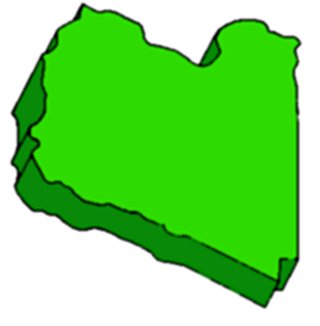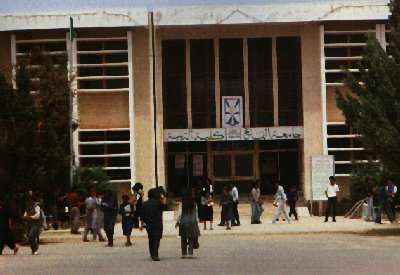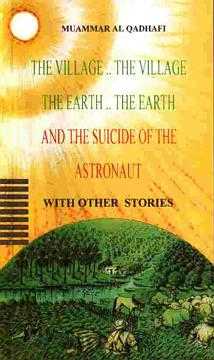Definition: “Jamahiriya — a society for all where all human beings are free and equal in the exercise of power and in the possession of wealth and arms.”
From Mathaba.net:

The Great Socialist People’s Libyan Arab Jamahiriya is situated in North Africa, stretching along the Mediterranean shoreline for nearly 2,000 kilometres. Its area is 1,775,500 square kilometres making it the fourth largest country in Africa. Egypt is on its eastern border; Sudan, Chad and Niger are to the south and Tunisia and Algeria lie to the west.
The population of just over four million is concentrated in the cities, villages and farming areas along the coastal strip.
Almost one million Libyans died during the Italian occupation from 1911 to 1944.
The administrative system in Libya is summed up in the word Jamahiriya, which literally means “the state of the masses.” The country is run by complete popular authority with no place for the traditional structures. Authority, wealth and the arms are all in the hands of the people.
Everywhere there are Basic People’s Conferences — from every village, city and town up to the General People’s Congress. The Conferences decide all matters of policy and their decisions are carried out by People’s Committees with the assistance and guidance of the voluntary Revolutionary Committees.
Vast areas of arid land in the desert have been turned into green and fertile tracts since the Al-Fateh Revolution of 1969. “The Green Revolution” is aimed at developing large areas of agriculture to produce complete self sufficiency in food. In the early 1950s Libya was officially rated by the United Nations as the poorest country in the world. Today, it is one of the wealthiest.
At the heart of Libya’s transformation since the 1969 Al-Fateh Revolution has been the mobilisation of the masses in direct control over society.
When armed workers march proudly through the Green Square on the 25th anniversary of the revolution, it symbolises the way in which real power was transferred to the people.
It is a unique experiment in direct democracy that was launched at the highest levels in March 1977, with the declaration of the establishment of popular authority and the rise of the age of the Jamahiriya — the state of the masses.
None of Libya’s outstanding achievements in the fields of education, health, housing, industry and agriculture could have been won without this fight to encourage the masses to become the masters of their own destiny.

Libyan university
After the September revolution the first political structure was set up within the framework of the Arab Socialist Union. This in itself was a big step forward for the people after almost 20 years of rule by a puppet monarchy accompanied by a parliamentary facade.
However the domestic and international tasks of the revolution soon outgrew that framework and the menacing bureaucracy it cultivated.
In 1973, Muammar Qadhafi, the leader of the revolution, called for a popular uprising to set up People’s Committees in all government departments, factories, communities, farms, schools and universities. His call for administrative revolution resulted in mass marches on all government establishments.
In December 1976, Qadhafi called on the People’s Committees to go further by initiating action to articulate the popular will instead of merely approving and supervising plans by the various ministries.
A major national debate was inaugurated to determine the best political and constitutional arrangements for the realisation of popular power.
In March 1977, the first General People’s Conference of over 1,000 delegates from the People’s Committees, professional associations, and unions, gathered to create a political system unlike any other in modern history.
In the declaration of March 1977, the Republic of Libya became known as the “Socialist People’s Libyan Arab Jamahiriya”.
“Direct popular authority constitutes the basis of the political system,” in the Jamahiriya, the declaration stated. Authority is for the people, and none else. The people exercise their authority through the Basic People’s Conferences, People’s Committees, syndicates, unions, and professional associations, and the General People’s Congress.
Libyans realise that the fate of their revolution depends on finding the road through which the masses on every continent can overthrow capitalism once and for all.
Muammar Qadhafi’s Green Book is the highest product of this struggle. Setting out to perfect a Third Universal Theory (beyond materialistic capitalism and atheism), Colonel Qadhafi’s three volume thesis declares that the solution to the problem of democracy is the absolute authority of the people.
It begins with a bitter indictment of the fraud and hypocrisy of bourgeois “representative” government.
“The most tyrannical dictatorships the world has ever known have existed under the shadow of parliaments,” Colonel Qadhafi points out.
His observation comes from direct experience. From 1951 to 1969 Libya was ruled by a parliamentary monarchy under King Idris that was nothing more than a cloak for dictatorship by the capitalist powers and the multi-national oil companies.
“The system of elected parliaments is based on propaganda to win votes. It is a demagogic system in the real sense of the word, and votes can be bought and falsified,” the Green Book states.
“The people stand silently in long queues to cast their votes in the ballot boxes in the same way as they throw other papers into a dustbin.”
The solution? “People’s Conferences are the only means to achieve popular democracy.”
All over Libya the slogan is painted — “No Democracy Without People’s Conferences and Committees Everywhere”.
The above article is extracted from New Dawn No. 27 (September 1994).
For more information about Libyan society, culture and history:
Libya, Qadhafi and the Green Revolution
Libya’s Black Day: Italian Fascist Terrorism
http://mathaba.net/info/info.htm
For information concerning American State terrorism against the people of Libya:
The Continuing Terror Against Libya
Bibliography

The Green Book
by Muammar Al Qadhafi

The Village...the Village...the Earth...the Earth and the Suicide of the Astronaut - with Other Stories
by Muammar Al Qadhafi
The Continuing Terror Against Libya
by Fan Yew Teng
Pirates and Emperors, Old and New:
International Terrorism in the Real World
by Noam Chomsky
The Real Terror Network:
Terrorism in Fact and Propaganda
by Edward S. Herman
The Fire This Time:
U.S. War Crimes in the Gulf
by Ramsey Clark
Desert Slaughter:
The Imperialist War Against Iraq
by the Workers League
Western State Terrorism
Alexander George, editor; essays by Noam Chomsky, Edward S. Herman, Gerry O’Sullivan and others
Terrorizing the Neighborhood:
American Foreign Policy in the Post-Cold War Era
by Noam Chomsky
Pressure Drop Press, 1991
The Culture of Terrorism
by Noam Chomsky
Rogue State:
A Guide to the World’s Only Superpower
by William Blum
Killing Hope:
U.S. Military and CIA Interventions Since WWII
by William Blum
Against Empire
by Michael Parenti
The Sword and the Dollar:
Imperialism, Revolution and the Arms Race
by Michael Parenti
The Habits of Highly Deceptive Media:
Decoding Spin and Lies in Mainstream News
by Norman Solomon
Inventing Reality:
The Politics of News Media
by Michael Parenti
Manufacturing Consent:
The Political Economy of the Mass Media
by Edward S. Herman and Noam Chomsky
Deadly Deceits:
My 25 years in the CIA
by Ralph W. McGehee
War, Lies & Videotape:
How media monopoly stifles truth
edited by Lenora Foerstel; multiple authors